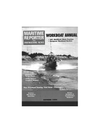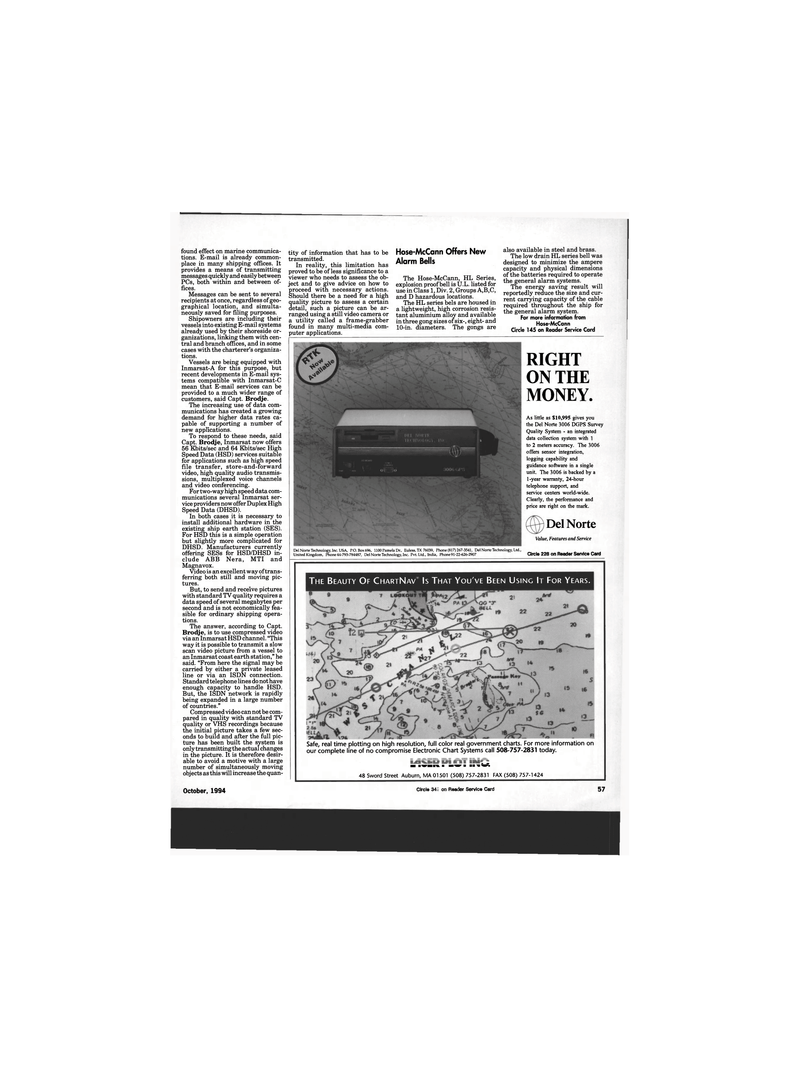
Page 70: of Maritime Reporter Magazine (October 1994)
Read this page in Pdf, Flash or Html5 edition of October 1994 Maritime Reporter Magazine
found effect on marine communica- tions. E-mail is already common- place in many shipping offices. It provides a means of transmitting messages quickly and easily between
PCs, both within and between of- fices.
Messages can be sent to several recipients at once, regardless of geo- graphical location, and simulta- neously saved for filing purposes.
Shipowners are including their vessels into existing E-mail systems already used by their shoreside or- ganizations, linking them with cen- tral and branch offices, and in some cases with the charterer's organiza- tions.
Vessels are being equipped with
Inmarsat-A for this purpose, but recent developments in E-mail sys- tems compatible with Inmarsat-C mean that E-mail services can be provided to a much wider range of customers, said Capt. Brodje.
The increasing use of data com- munications has created a growing demand for higher data rates ca- pable of supporting a number of new applications.
To respond to these needs, said
Capt. Brodje, Inmarsat now offers 56 Kbits/sec and 64 Kbits/sec High
Speed Data (HSD) services suitable for applications such as high speed file transfer, store-and-forward video, high quality audio transmis- sions, multiplexed voice channels and video conferencing.
For two-way high speed data com- munications several Inmarsat ser- vice providers now offer Duplex High
Speed Data (DHSD).
In both cases it is necessary to install additional hardware in the existing ship earth station (SES).
For HSD this is a simple operation but slightly more complicated for
DHSD. Manufacturers currently offering SESs for HSD/DHSD in- clude ABB Nera, MTI and
Magnavox.
Video is an excellent way of trans- ferring both still and moving pic- tures.
But, to send and receive pictures with standard TV quality requires a data speed of several megabytes per second and is not economically fea- sible for ordinary shipping opera- tions.
The answer, according to Capt.
Brodje, is to use compressed video via an Inmarsat HSD channel. "This way it is possible to transmit a slow scan video picture from a vessel to an Inmarsat coast earth station," he said. "From here the signal may be carried by either a private leased line or via an ISDN connection.
Standard telephone lines do not have enough capacity to handle HSD.
But, the ISDN network is rapidly being expanded in a large number of countries."
Compressed video can not be com- pared in quality with standard TV quality or VHS recordings because the initial picture takes a few sec- onds to build and after the full pic- ture has been built the system is only transmitting the actual changes in the picture. It is therefore desir- able to avoid a motive with a large number of simultaneously moving objects as this will increase the quan- tity of information that has to be transmitted.
In reality, this limitation has proved to be of less significance to a viewer who needs to assess the ob- ject and to give advice on how to proceed with necessary actions.
Should there be a need for a high quality picture to assess a certain detail, such a picture can be ar- ranged using a still video camera or a utility called a frame-grabber found in many multi-media com- puter applications.
Hose-McCann Offers New
Alarm Bells
The Hose-McCann, HL Series, explosion proof bell is U.L. listed for use in Class 1, Div. 2, Groups A,B,C, and D hazardous locations.
The HL series bels are housed in a lightweight, high corrosion resis- tant aluminium alloy and available in three gong sizes of six-, eight- and 10-in. diameters. The gongs are also available in steel and brass.
The low drain HL series bell was designed to minimize the ampere capacity and physical dimensions of the batteries required to operate the general alarm systems.
The energy saving result will reportedly reduce the size and cur- rent carrying capacity of the cable required throughout the ship for the general alarm system.
For more information from
Hose-McCann
Circle 145 on Reader Service Card
RIGHT
ON THE
MONEY.
As little as $10,995 gives you the Del Norte 3006 DGPS Survey
Quality System - an integrated data collection system with 1 to 2 meters accuracy. The 3006 offers sensor integration, logging capability and guidance software in a single unit. The 3006 is backed by a 1-year warranty, 24-hour telephone support, and service centers world-wide.
Clearly, the performance and price are right on the mark.
Del Norte
Value, Features and Service
Del Norte Technology, Inc. USA, P.O. Box 696, 1100 Pamela Dr., Euless.TX 76039, Phone (817) 267-3541, Del Norte Technology, Ltd.,
United Kingdom, Phone 44-793-784487, Del Norte Technology, Inc. Pvt. Ltd., India, Phone 91-22-626-2907 Circle 228 On Reader Service Card
THE BEAUTY OF CHARTNAV® IS THAT YOU'VE BEEN USING IT FOR YEARS.
Safe, real time plotting on high resolution, full color real government charts. For more information on our complete line of no compromise Electronic Chart Systems call 508-757-2831 today. m • waaam • mm-mr • aavW* 48 Sword Street Auburn, MA 01501 (508) 757-2831 FAX (508) 757-1424
October, 1994 Circle 334 on Reader Service Card 57

 69
69

 71
71
